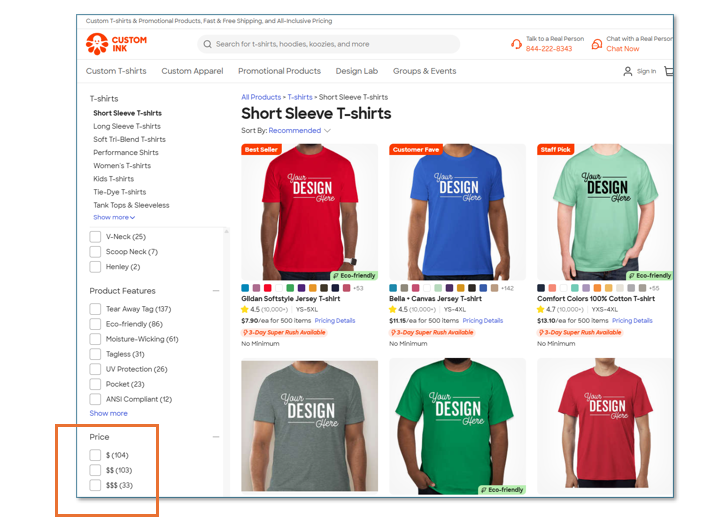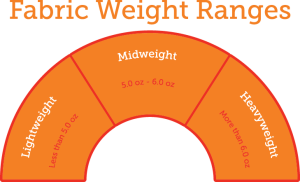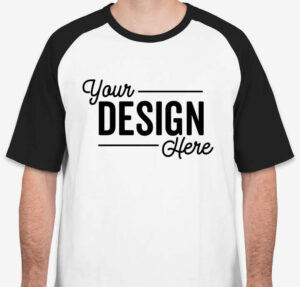How to Create the Perfect Custom T-shirt
If you’re overwhelmed by the thought of designing the perfect custom t-shirt for your team, group, or family, let us help. It can be hard to know where to start, so we’ve broken the process down into simple steps that you can follow and be confident that when you receive your custom shirts, they’ll be exactly what you need.
By the end of this guide, you’ll feel equipped and inspired, and will know how to create custom t-shirts that your group will love. We’ve included insider advice from Arlie Chupeco, our Senior Category Manager and a true t-shirt printing expert!
You’ll learn:
- How to stay within your budget.
- How to choose a t-shirt style, fabric, and weight.
- How to easily add your existing design to a t-shirt or create a new design.
- How to finalize the order (using bulk ship or individual shopping options) and receive it when you need it.
Key Takeaways
- Custom t-shirt costs are influenced by quantity, material quality, design complexity, and shipping, allowing you to tailor an order to your budget.
- Choosing the perfect base shirt involves balancing fabric (cotton, polyester, blends), weight, and style to best suit your group’s purpose and preference.
- Custom Ink’s Design Lab makes creating unique t-shirt designs easy, complemented by flexible ordering and delivery options like single or group shipments.
Step 1: How to Stay Within Your Budget
Before you jump into customizing the design of the t-shirt, think about your budget. Your order cost depends on:
- The number of shirts in the order (the cost per shirt is lower for higher volume orders)
- The base shirt you select (premium brands and fabrics cost more)
- The number of colors in the design (to lower costs, choose between 1-3 colors) and whether you use specialty inks that add to the cost (such as glitter)
- The number of print locations (printing on both the front and back of the shirt or on the sleeves is more expensive than printing a single shirt location)
- The shipping speed (standard orders that are delivered within two weeks are free; costs increase for rush orders)
If you’re ordering six shirts or less, filter your search to no-minimum t-shirts. If your order is larger, you’ll have access to more styles, fabrics, and price breaks, and it might be easier to create something that feels unique to your group.
Arlie’s Tip: “With more bells and whistles, prices usually go up. To stay within budget, try shifting between “$,” “$$,” and “$$$” filters on the left side of the page.”
Step 2: How to Choose Your Base Shirt: Fit, Fabric, and Weight
We have high-quality shirt choices for all budgets. Typically, when you need to reduce costs, we recommend choosing a higher quality fabric and fit over a more complicated and pricey design, as the higher the quality, the more likely the shirt will be worn over and over.
Fabric and weight shape how a t-shirt feels, how long it lasts, and even how it fits your group’s needs.
Fabric
The most common fabric (also called material) options are:
- 100% Cotton: 100% cotton is classic. Ringspun and combed ringspun cotton are the softest and most durable versions — perfect if you want a premium feel without breaking the bank. You can always find information about the type of cotton in the product description.
To find ringspun cotton, filter the list of shirts by Material > 100% cotton and then look for the fabric details in the Description and Features section.
-
- Ringspun cotton is made by twisting the cotton strands, which makes the fabric softer and more durable than regular cotton.
- Combed ringspun cotton takes it a step further by combing out short fibers and impurities before spinning, resulting in an even smoother, finer, and stronger fabric.
Fun fact: Last year, we upgraded our basic cotton t-shirt to a heavier-weight ringspun option at the same price, so if you choose the default t-shirt, you’ll get a high-quality ringspun cotton that looks and feels great.
What’s an organic t-shirt? T-shirts listed as ‘organic’ are made of 100% cotton material grown in sustainable, eco-friendly conditions, with no harmful synthetic dyes or chemicals added during production. To qualify as organic, production processes must meet the standards for organically-produced agricultural products set forth by the USDA National Organic Program. You can check to see if a t-shirt is made from organic cotton by checking the description and features section.
- 100% Polyester: Known as “performance shirts,” polyester tees are lightweight, moisture-wicking, and a go-to for sports and activewear.
- Blends: Blends combine cotton with synthetic fibers, giving you the best of both worlds. Tri-blend t-shirts are especially popular for their buttery-soft feel. They stretch for comfort but bounce back to their original shape, wash after wash.
- UV protection: Many synthetic fabrics provide UPF protection, reducing UV exposure. What is UPF? UPF stands for Ultraviolet Protection Factor and works like sun protection for clothing, resulting in fabric that blocks the sun’s harmful UV rays. A higher UPF number means better protection. For example, a shirt with UPF 50 lets only about 2% of UV rays reach your skin.
If you’re ordering custom t-shirts for building contractors, for instance, you may want to choose long-sleeve hooded performance tees with built-in sun protection. To create a custom t-shirt with sun protection built in, filter by UV protection.
- Eco-friendly: Our eco-friendly t-shirts are made from recycled fabrics and provide sustainable options.
Weight
Our t-shirts range from lightweight 4 oz. styles to heavyweight 9 oz. options. Anything above 6 oz. is considered heavyweight, which gives a substantial feel.
The ounce weight indicates the weight of a square yard of a shirt’s fabric material. Most t-shirts and polos can be categorized as lightweight, midweight, or heavyweight.
- Lightweight: Under 5.0 oz.
- Midweight: Between 5.0 and 6.0 oz.
- Heavyweight: Over 6.0 oz.
Arlie’s tip: “Heavyweight doesn’t always mean better, but it does add perceived value. If you’re ordering for employee swag or giveaways, a heavier shirt can leave a lasting impression.”
Style
A t-shirt may look simple at first, but every element — from sleeves to necklines — can be customized to suit your goals. Here are a few available options:
-
- Fit:
- Classic – filter by standard fit
- fitted – we have two fitted style options: semi-fitted and slim fit
- oversized – provides a relaxed, comfortable feel (filter by relaxed fit)
- Fit:
-
-
- cropped/boxy
-
- Sleeves:
- Pockets:
-
- no pocket – for a classic and minimal look
- chest pocket – a pocket can not only elevate the look of a t-shirt, but can be useful for storing a pen or pencil (for instance, for a restaurant server or construction worker)
-
- Neck:
-
- Hooded – can be useful for those working outdoors in the sun or rain
With more than 10 styles available and plenty of customization options, you can easily match your shirts to your vision. Want a retro vibe? Go for raglan sleeves. Looking for something sleek? A fitted cut with a crew neck works perfectly.
Arlie’s Tip: “Oversized t-shirts will always be in style, but lots of women also go for boxy cuts. These relaxed, cropped t-shirts fall to the waistline and can be worn tucked in for a chic look or untucked for a casual vibe.”
Step 3: How to Design Your Custom T-shirts
Once you’ve chosen our blank t-shirt, you can bring your idea to life! Our easy-to-use Design Lab is an online t-shirt creator that anyone can use create a great-looking piece of swag, no t-shirt design experience required.
You can upload your own images and logos, add text in a wide variety of fonts, or choose from ready-made elements in our design library. You can print onto shirt fronts, backs, and sleeves. You can then preview your design to ensure it’s exactly right.
Our tips for great t-shirt design:
- Keep it simple and easily identifiable (such as a logo or short phrase)
- Don’t use too many colors or fonts
- Make sure the design colors contrast well with the base color (choose a light design on a dark color shirt and a dark design on a light color shirt)
- To elevate the design, add subtle details such as a name or tagline on a sleeve
- Consider your audience: will they prefer oversized comfort and a fun design or a more professional and crisp look?
Step 4: How to Set Up Your T-shirt Order and Delivery
The last step is making sure your shirts get to everyone on time. Choose between:
- Single shipment. Pay for the full batch and have everything delivered to one address. Perfect if you’re handing them out in person.
- Group Orders. Design the shirt, share a link, and let each person enter their size, payment, and address. No need to chase down checks or sizes. Each shirt will be delivered individually to each person.
Standard two week delivery is free with every order, but if you need your custom t-shirts sooner, we have one week and three day rush delivery available.
We’re Here to Help
As you design your custom t-shirt, our Inkers are here to guide you every step of the way. Whether you’re outfitting a school club, company team, or family reunion, we’ll help make your vision a reality. Contact us or start designing online today, and let’s bring your perfect t-shirt to life!




















Leave a Comment